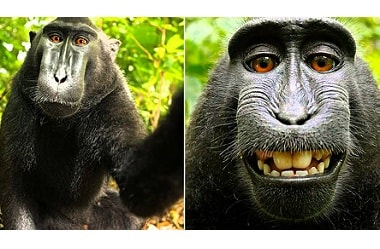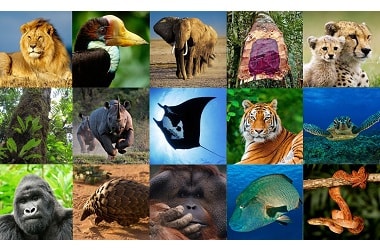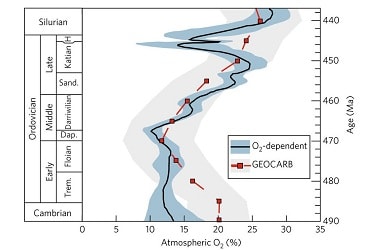Environment - Current Affairs for December, 2017
Environment Current Affairs for December, 2017
Month wise coverage of Environment Current Affairs helps you improve your general knowledge and prepare for all competitive exams like IBPS, Bank PO, SBI PO, RRB, RBI, LIC, Specialist Officer, Clerk, SSC, UPSC, Railway etc. This section is updated daily with the most important events.Preparing Environment Current Affairs December, 2017
1. Read the most important Environment Current affairs and facts here. 2. Take practice test of our Environment MCQ and Objective type questions. 3. Clear any quiz, GK, job interview or competitive exam on current affairs.
- Month & Year
▼ Kacheguda - First energy efficent rail station in India [12-11-17]
 Kacheguda Railway Station under the South Central Railway (SCR) has earned the unique distinction of being the first Energy Efficient 'A1 Category' Railway Station on Indian Railways.
The station has achieved 100% energy efficiency by replacing 1,312 conventional lights with light-emitting diode (LED) lighting, among other steps.
About 370 ceiling fans, too, were replaced with energy efficient Brushless DC Electrical (BLDC) motors fans, and 12 air conditioners with energy efficient inverter-type air conditioners.
All these measures would save about 1.76 lakh units and Rs.14.08 lakh per annum with reduction of the connected load by 46.18 kW for Railways.
Kacheguda Railway station is a historic building and had completed 100 years.
Situated in the heart of Hyderabad, it was built in 1916 by the Nizam's Guaranteed State Railway during the reign of Mir Osman Ali Khan, the seventh Nizam. Kacheguda Railway Station under the South Central Railway (SCR) has earned the unique distinction of being the first Energy Efficient 'A1 Category' Railway Station on Indian Railways.
The station has achieved 100% energy efficiency by replacing 1,312 conventional lights with light-emitting diode (LED) lighting, among other steps.
About 370 ceiling fans, too, were replaced with energy efficient Brushless DC Electrical (BLDC) motors fans, and 12 air conditioners with energy efficient inverter-type air conditioners.
All these measures would save about 1.76 lakh units and Rs.14.08 lakh per annum with reduction of the connected load by 46.18 kW for Railways.
Kacheguda Railway station is a historic building and had completed 100 years.
Situated in the heart of Hyderabad, it was built in 1916 by the Nizam's Guaranteed State Railway during the reign of Mir Osman Ali Khan, the seventh Nizam.
|
▼ Indonesian monkey Naruto is PETA person of the year! [12-7-17]
 An Indonesian monkey who shot to fame after it snapped a grinning selfie - and sparked a landmark U.S. copyright case - was named "Person of the Year" on Dec 6, 2017 by the animal rights group that took on the simian's cause.
The People for the Ethical Treatment of Animals (PETA) said it was honouring Naruto, a crested black macaque with a goofy-looking grin, to recognise that "he is someone, not something".
In 2011, the monkey pressed the shutter button while staring down the lens of a camera set up British nature photographer David Slater on the island of Sulawesi.
The photos quickly went viral and PETA launched a lawsuit that claimed the then six-year-old Naruto should be "declared the author and owner of his photograph".
Naruto's historic selfie challenged the idea of who is a person and who is not and resulted in the first-ever lawsuit seeking to declare a nonhuman animal the owner of property, rather than being declared property himself.
PETA: Know More An Indonesian monkey who shot to fame after it snapped a grinning selfie - and sparked a landmark U.S. copyright case - was named "Person of the Year" on Dec 6, 2017 by the animal rights group that took on the simian's cause.
The People for the Ethical Treatment of Animals (PETA) said it was honouring Naruto, a crested black macaque with a goofy-looking grin, to recognise that "he is someone, not something".
In 2011, the monkey pressed the shutter button while staring down the lens of a camera set up British nature photographer David Slater on the island of Sulawesi.
The photos quickly went viral and PETA launched a lawsuit that claimed the then six-year-old Naruto should be "declared the author and owner of his photograph".
Naruto's historic selfie challenged the idea of who is a person and who is not and resulted in the first-ever lawsuit seeking to declare a nonhuman animal the owner of property, rather than being declared property himself.
PETA: Know More
- People for the Ethical Treatment of Animals is an American animal rights organization based in Norfolk, Virginia, and led by Ingrid Newkirk, its international president.
- A nonprofit corporation with nearly 400 employees, it claims that it has 6.5 million members and supporters, in addition to claiming that it is the largest animal rights group in the world.
- Its slogan is "Animals are not ours to eat, wear, experiment on, use for entertainment, or abuse in any other way."
- Founded in March 1980 by Newkirk and fellow animal rights activist Alex Pacheco, the organization first caught the public's attention in the summer of 1981 during what became known as the Silver Spring monkeys case, a widely publicized dispute about experiments conducted on 17 macaque monkeys inside the Institute of Behavioral Research in Silver Spring, Maryland.
- PETA focuses on four core issues-opposition to factory farming, fur farming, animal testing, and the use of animals in entertainment.
- It also campaigns for a vegan lifestyle and against eating meat, fishing, the killing of animals regarded as pests, the keeping of chained backyard dogs, cock fighting, dog fighting, and bullfighting.
|
▼ IUCN updates red list [12-6-17]
 The International Union for Conservation of Nature (IUCN) on Dec 4, 2017 released an updated red list classifying the different species.
According to their website,the IUCN Red List Categories are intended to be an easily and widely understood system for classifying species at high risk of global extinction.
The categories are: The International Union for Conservation of Nature (IUCN) on Dec 4, 2017 released an updated red list classifying the different species.
According to their website,the IUCN Red List Categories are intended to be an easily and widely understood system for classifying species at high risk of global extinction.
The categories are:
- EXTINCT - the last individual in the species has died.
- EXTINCT IN THE WILD - it now lives only in captivity and not in its natural habitat.
- CRITICALLY ENDANGERED - facing an extremely high risk of extinction in the wild.
- ENDANGERED - facing a very high risk of extinction in the wild.
- VULNERABLE - facing a high risk of extinction in the wild.
- NEAR THREATENED - likely to qualify for a threatened category in the near future.
- LEAST CONCERN - it is widespread and abundant in the wild.
- DATA DEFICIENT - inadequate information.
- NOT EVALUATED - not yet been evaluated against the criteria.
|
▼ CITE commends India for tackling wildlife trade [12-4-17]
 India was awarded certificate of commendation for its effort to combat illegal wildlife trade by Convention on International Trade in Endangered Species of Wild Fauna and Flora (CITES).
The award was given to Wildlife Crime Control Bureau (WCCB) for its efforts in conducting and coordinating species-specific wildlife enforcement operation, codenamed 'Operation Save Kurma'.
It recognises exemplary enforcement action of WCCB's regional and global effort to combat illegal wildlife trade. India was awarded certificate of commendation for its effort to combat illegal wildlife trade by Convention on International Trade in Endangered Species of Wild Fauna and Flora (CITES).
The award was given to Wildlife Crime Control Bureau (WCCB) for its efforts in conducting and coordinating species-specific wildlife enforcement operation, codenamed 'Operation Save Kurma'.
It recognises exemplary enforcement action of WCCB's regional and global effort to combat illegal wildlife trade.
|
▼ Effect of boost in Oxygen level 485 million years ago! [12-1-17]
 A boost in levels of oxygen may have caused a three-fold increase in biodiversity during between 445 and 485 million years ago, a study has found.
The explosion of diversity, recognised as the Great Ordovician Biodiversification Event, brought about the rise of various marine life, tremendous change across species families and types, as well as changes to the Earth, starting at the bottom of the ocean floors.
This oxygenation is supported by two approaches that are mostly independent from each other, using different sets of geochemical records and predicting the same amount of oxygenation occurred at roughly the same time as diversification.
During the Ordovician where near-modern levels of oxygen were reached about 455 million years ago.
It should be stressed that this was probably not the only reason why diversification occurred then. It is likely that other changes - such as ocean cooling, increased nutrient supply to the oceans and predation pressures - worked together to allow animal life to diversify for millions of years.
Chemical signatures of Oxygen Increase: Know More A boost in levels of oxygen may have caused a three-fold increase in biodiversity during between 445 and 485 million years ago, a study has found.
The explosion of diversity, recognised as the Great Ordovician Biodiversification Event, brought about the rise of various marine life, tremendous change across species families and types, as well as changes to the Earth, starting at the bottom of the ocean floors.
This oxygenation is supported by two approaches that are mostly independent from each other, using different sets of geochemical records and predicting the same amount of oxygenation occurred at roughly the same time as diversification.
During the Ordovician where near-modern levels of oxygen were reached about 455 million years ago.
It should be stressed that this was probably not the only reason why diversification occurred then. It is likely that other changes - such as ocean cooling, increased nutrient supply to the oceans and predation pressures - worked together to allow animal life to diversify for millions of years.
Chemical signatures of Oxygen Increase: Know More
- Using geochemical proxies, high-resolution data and chemical signatures preserved in carbonate rocks formed from seawater, researchers were able to identify an oxygen increase during the Middle and Late Ordovician periods.
- They found a nearly 80% increase in oxygen levels where oxygen constituted about 14% of the atmosphere during the Darriwilian Stage (Middle Ordovician 460-465 million years ago) and increased to as high as 24% of the atmosphere by the mid-Katian (Late Ordovician 450-455 million years ago).
- This study suggests that atmospheric oxygen levels did not reach and maintain modern levels for millions of years after the Cambrian explosion, which is traditionally viewed as the time when the ocean-atmosphere was oxygenated.
- In this research, scientists were able to show that the oxygenation of the atmosphere and shallow ocean took millions of years, and only when shallow seas became progressively oxygenated were the major pulses of diversification able to take place.
|